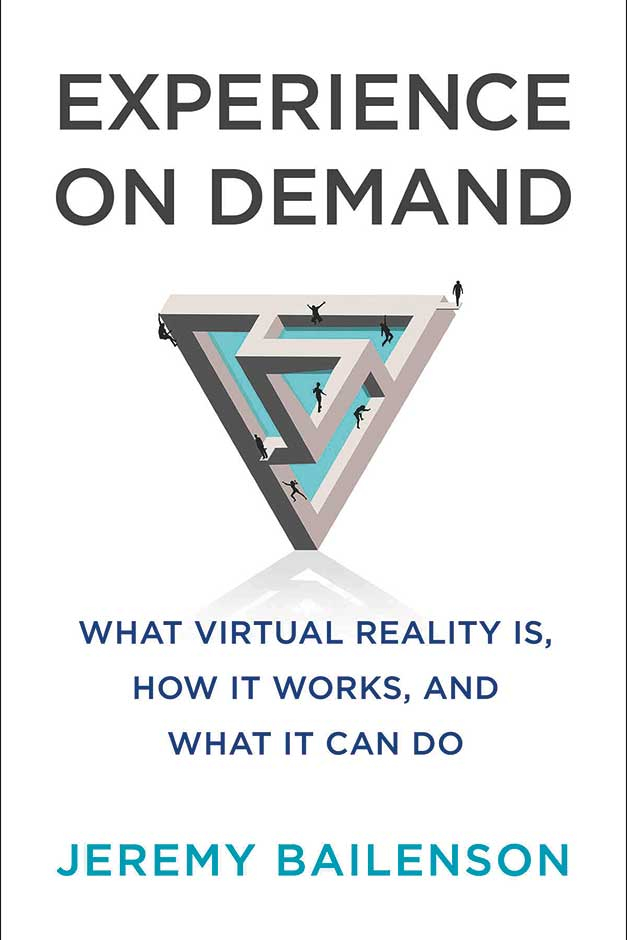Jaron Lanier’s book Dawn of the New Everything and Jeremy Bailenson’s Experience on Demand discuss the history and present cutting edge of virtual reality technology, framing it as a potentially useful if not transformative tool for enlarging human empathy, perfecting skills, overcoming trauma and engaging with others. They spend much less time on the possible dangers of VR as we move into the future.
Bailenson is the director of the Virtual Human Interaction Lab at Stanford, and most of his book reads like a remarkably interesting report on the cool new experiments he’s conducting. He’s found that virtual reality can help people overcome PTSD, endure painful skin-grafting procedures and practice surgery. An early chapter deals with quarterbacks using the technology to go over what they might have missed during practice. And although his discussion of certain applications of VR can sometimes read like an advertisement, he gets what it’s really good at, at least for the time being: creating pricey, immersive experiences that are planned in advance, either by capturing something live or by creating it.
By Jaron Lanier, Henry Holt and Company, 351 pages, $30
The NFL knows that the moment a quarterback gets the ball, a million things will happen over the next few seconds that can be caught by expensive cameras, and they made the bet that the cost of capturing those moments to train one person to be better at his job would be worth it. The other objective, committing the time and resources to build something immersive — say, underwater field trip experiences for children who would not otherwise have the chance to swim with sharks — needs more broad application to justify the currently steep price.
Bailenson defines VR as a scientific and cultural tool. He explores the idea of creating interactive stories — and even has words of advice for their would-be directors — but it’s clear that he’s first and foremost a scientist, testing hypotheses and proposing new therapies.
Lanier’s book is, by contrast, intimate and idiosyncratic. He carries us through his quirky and fascinating life story, with periodic nerdy side trips through his early thinking on more technical aspects of virtual reality. If you liked Richard Feynman’s autobiographical Surely You’re Joking, Mr. Feynman but thought it was rather self-indulgent, this book will prompt similar reactions. You could almost say that Lanier’s vivid and creative imagination is a distinct character in this book, he discusses it so much. Midway through, Feynman himself makes an appearance, and it seems as if we’re meeting an old friend.
Lanier has been credited with inventing the term “virtual reality,” and he founded one of the original companies to produce it, VPL Research. He goes over the technology’s history in detail, outlining not only the obstacles to getting consistent hardware but some personalities and interpersonal conflicts that ultimately led to his company’s breaking up. He also demonstrates the role personal connections and interactions play in Silicon Valley. This narrative illuminates the overlooked importance of women, referred to by Lanier as GNFs, for Grand Networking Females, in making the connections and taking up the work essential to starting tech companies. For example, at the moment that Lanier was offered start-up funding and needed a corporate lawyer, a GNF introduced him to the right people. Although Lanier goes out of his way to give credit to these women, I’m left with that familiar sinking feeling that, although successful in their own right, they formed the social glue upon which all companies depended but never became as famous as the men they helped.
By Jeremy Bailenson, W. W. Norton & Company, 290 pages, $29
In the late 1980s, Lanier was a sought-after speaker in California, an enthusiastic supporter for theoretical, mind-bending experiences that technology would someday offer to audiences of blissed-out hippies. (Lanier discusses lots of drug use in the book but says he doesn’t personally partake, “not even marijuana.”) Two consequences of this early guru persona come out in the book: First, he offers dozens of different definitions of VR as a holistic force and cure-all. Second, he comes off as both a technically savvy inventor and a cult leader.
As cult leaders go, he seems nice, and certainly preferable to most of the current crop of would-be Silicon Valley cult leaders. His vision is humanistic, and he insists that the most important goal of developing virtual reality is human connection, although he does talk about the fascination of seeing his own hand in VR a bit too often to be convincing on that point. He takes on ideology. He dismisses what he describes as the libertarian ideals that have replaced his friends the hippies, and more recently he strongly objects to the new Silicon Valley religion based on the all-powerful possibilities of artificial intelligence. “Every time you believe in AI you are reducing your belief in human agency and value,” he claims, and goes on to define virtual reality as “-AI,” the inverse of AI, although whether he’s referring to technology or ideology he doesn’t clarify.
Where Bailenson makes virtual reality more approachable and less like magic, as you’d expect from an academic scientist, Lanier plows into philosophy and expands the limits of what VR might achieve, blurring definitional lines and sometimes making it all sound truly surreal.
In focusing on their authors’ own contributions to the development of this tool, these books miss a vital part of the discussion of virtual reality — the world of VR once the technology gets really good. They both mention the holodeck on Star Trek, a realistic and boundless virtual environment requiring no headset and causing no “VR sickness,” which stood as the background for countless episodes featuring tech failures and ethical dilemmas in subsequent Star Trek spinoff series.
What Star Trek writers got right, and what both authors seem to miss or deliberately avoid, is that virtual reality is just a tool, and can be used for good or evil. Imagine the propaganda that can be developed once people can experience something almost firsthand. Far from being its opposite, VR can combine with AI but imagine what would happen if abusive or paedophiliac makers got their hands on the controls. Instead of PTSD therapy, VR could be used for torture. I’m not trying to be cynical, just realistic: Once video became easy to manufacture, people started contributing widely to YouTube. And although I enjoy learning new knitting techniques on that platform, we have recently seen widespread propaganda and depraved cartoons that fool the recommendation algorithms into suggesting them for children. There’s no reason to imagine this won’t happen on a virtual reality platform when the time comes, which could be soon.
Why the blind spot? I think it’s because the authors are themselves the current gatekeepers of this exciting technology, and although they plan for it to go mainstream, they desperately want it to be good for society. But Bailenson and Lanier cannot have it both ways: insisting that VR is very realistic, and thus affecting and potentially therapeutic, but also that it will be used only for good. That will happen only if it remains expensive and if the technology stalls. Fat chance.
People interested in the current state of virtual reality’s applications will enjoy Bailenson, and people interested in the cultural and technological history of VR will likewise enjoy Lanier. As for my concerns about its possible future abuses, we might have to rely on science fiction writers for now.
–New York Times News Service
Cathy O’Neil is the author of Weapons of Math Destruction.











